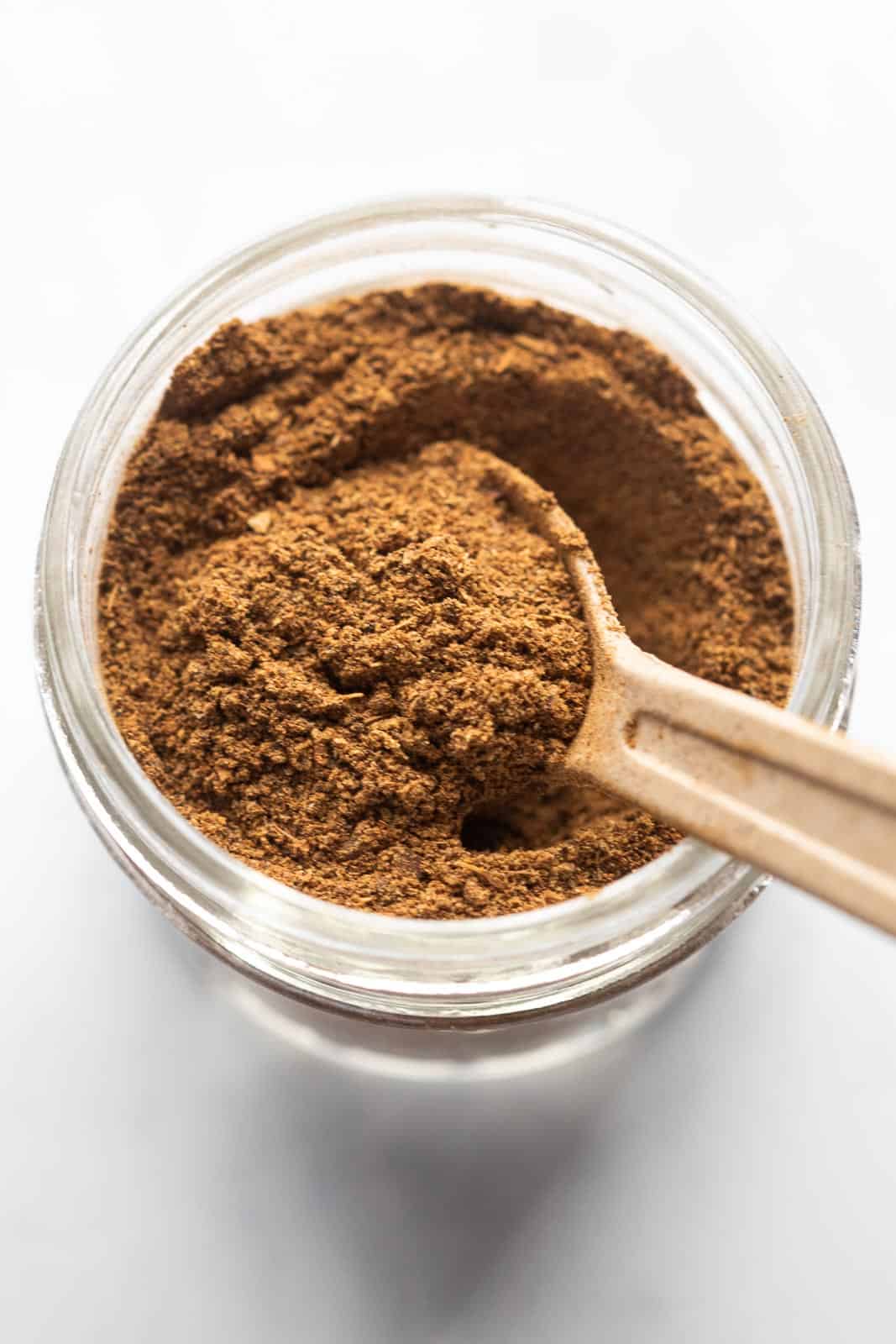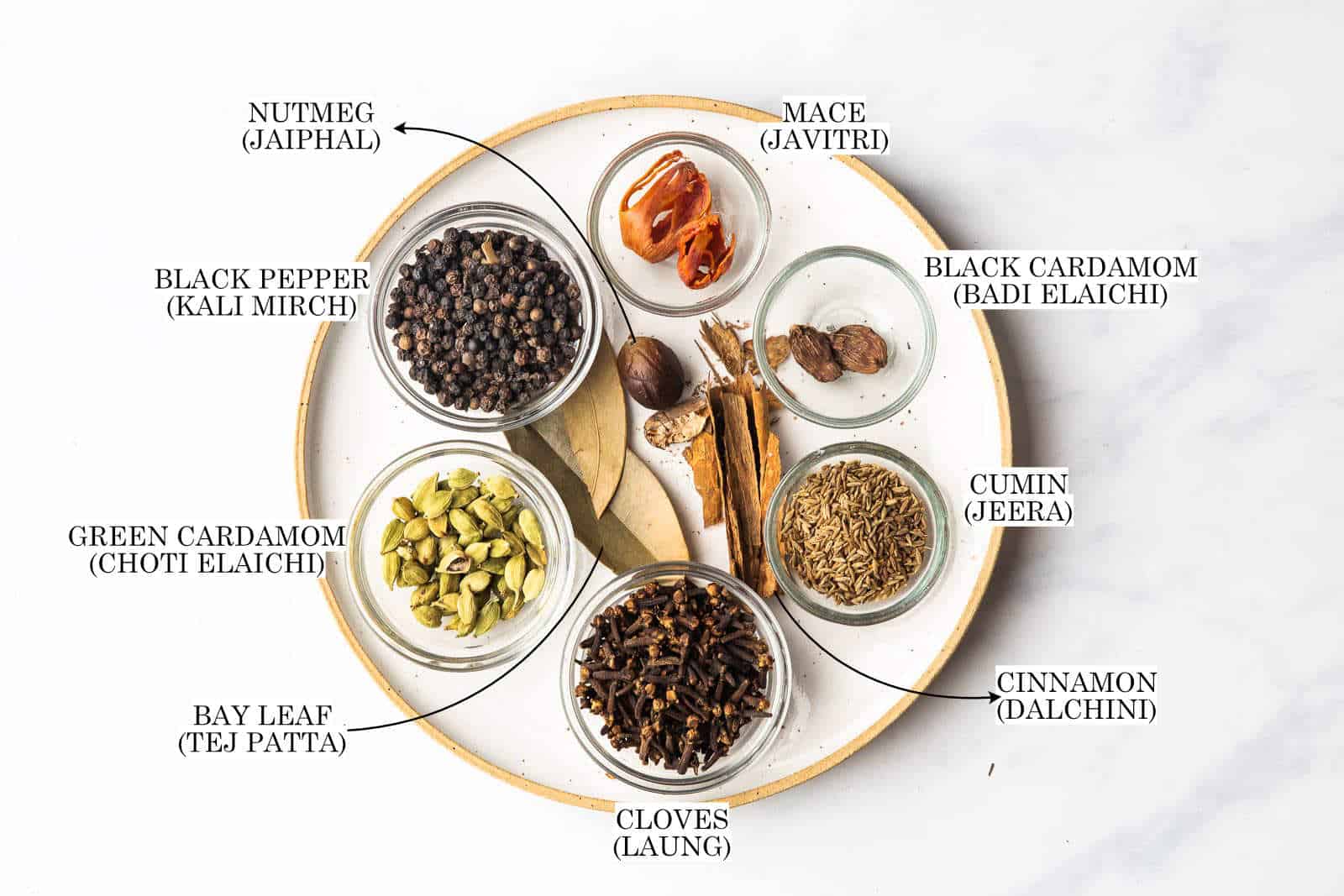Garam Masala is the king of Indian spice mixes, and every house should have a jar of this fragrant, complex spice blend. Used in a number Indian recipes, gravies and sabzi’s, a little goes a long way
Garam Masala is the quintessential Indian spice mix or blend that adds that hit of flavour to Indian cooking. It's really easy to make at home and I make a batch once a year. Homemade garam masala is definitely more fragrant, and more potent than store bought.

With garam masala, different families, different regions have different versions. And this is mine. This is how my mum and grandma have been making it for years.
What does Garam masala mean
Garam in Hindi means “hot” or “warm”. Masala just refers to any blend of spices. With Garam Masala, everyone either follows generational family recipes or buys one of the many brands available in markets.
Most likely, make than buy because there is nothing like homemade garam masala and it’s so simple, you’d wonder why you’d ever buy it.
Each region has its own fun spin on it. The punjabi garam masala is mild and mostly aromatic. It provides warmth. It was created to combat the harsh cold winters of North India - a recipe born from necessity. Black pepper serves as the only hot spice present in it amongst several sweet ones. This makes the blend pungent rather than spicy. Some North Indian recipes even find use of star anise.
Travelling south, we find that the blend features red chillies that provide heat to the mixture.
How to make Garam Masala
Buy or procure whole spices from a good source where you can be sure of their authenticity and freshness
Sundry the spices for a day or two. To sundry, spread them out on a large plate and cover them with a muslin cloth or a net to prevent dust or insects from coming in contact with the spices. Alternatively, you can also microwave them for 30 seconds. The purpose is to get rid of any moisture and not to roast or cook them
Finally, grind the spices to a smooth powder using the dry jar of a mixture grinder or a coffee grinder
This method of making garam masala results in kachha garam masala or uncooked garam masala. If you choose to roast your spices, it's called pakka garam masala

Roasting vs Sun Drying Spices
Unlike a lot of other recipes, I don’t roast the spices before blending them into Garam Masala. I let them sun dry for a day to get rid of any moisture. Or microwave them for 30 seconds. And then grind them to a fine powder. Roasting releases oils in spices and I would rather the oil stays intact, so that it’s released when it’s added to a hot dish. This is really a personal preference and how I’ve seen generations of women make Garam Masala in my family.
You can grind Garam Masala in the small jar of a mixer grinder, or use a coffee grinder.
Garam Masala vs Curry Powder
People outside India frequently confuse garam masala with curry powder.
However, Curry Powder is not a traditional Indian spice blend but rather an invention of British times. Most people in India don’t even use it in their cooking, though we have a few recipes on the blog that do, because we love its flavour and aroma. It is a standard mix of spices such as Fenugreek, Turmeric, Cumin, and Coriander. This blend is used to evoke the essence of a Curry. The main ingredient is Turmeric which gives Curry Powder its signature yellow colour. Overall its mild in flavour and is generally used in the beginning of the cooking process.
In contrast, Garam Masala is a traditional spice that has Indian origins. It is authentic to Indian cuisines and has no set recipes. It differs from region to region. Moreover, Garam Masala is mostly used towards the end of a cook.
Why make your own at home
I've always made my own Garam Masala powder at home. Store bought masala just doesn't cut it.
- When made at home, the Garam Masala powder retains its aroma for much longer. While making the mix at home, you have a better understanding of the nuances of the blend
- Homemade Garam Masala is made in small batches, so you can quickly whip it up and it can last you a few months if you store it in an airtight container. This ensures you always have the freshest flavours
- Based on what you like, you can customise the blend a little
How to Store for longer life
Store in an airtight container to prevent it from losing its wonderful aroma. It is best kept in a dark cupboard so that light cannot penetrate the spices, which helps them retain their taste longer. Refrigerating is not a good idea as the masala can come in contact with moisture, which can cause them to spoil faster. Just remember to store in airtight jars, away from sunlight, in a cool and dry place.
How to use Garam Masala
- Use it at the end: Traditionally, it is used right at the end of a recipe so that the aromas and flavors stay fresh from the oils released. Simmer the dish for another minute or two after adding it and then serve it.
- Avoid overuse: A little goes a long way - approx ¼ to ½ teaspoon homemade garam masala for a serving size of four is enough to flavour a dish. Too much will overpower the other flavours and make the dish bitter.
- Flexibility: The best part of garam masala is its flexibility. It is endless in the number of spices that go into making it, but also in the sense that there are no limits to how you can make use of it. Conventionally, it is used in a recipe as a seasoning to flavour meats, curries and veggies as it is so aromatic and fragrant. However, it can also be used as an ingredient in a dry rub or marinade. You can even use a pinch to spice up your tea and make some masala chai!
Benefits
It isn’t surprising to find out that Garam Masala has medicinal properties. It is full of antioxidants that help keep your skin clear. It also helps with nausea, bloating and digestion. The individual spices that make up the fine blend are amazingly beneficial themselves. For example:
- Peppercorns are rich in antioxidants
- Cinnamon usage has been recorded since as early as Ancient Egypt. The medicinal properties of cinnamon were regarded so highly that it was only consumed by the Egyptian Royals. Luckily today, cinnamon is much more ubiquitous. It is anti-inflammatory and also similar to peppercorns. Cinnamon usage has also been tracked to have anti diabetic properties and is popular for lowering blood sugar as well.
- Cardamom is one of the many spices that found its use in ancient medicine. Cardamom of both forms (green or black) has been linked with aiding the digestive system and reducing gastric problems. Green cardamom specifically is helpful for a good night's sleep. Black cardamom is believed to help fight the symptoms of asthma.
- Tej patta is also known around the world as Indian Bay Leaf. It is a potent source of Vitamins such as Vitamin A and Vitamin C. It also contains folic acid. It has been found that a diet rich in Bay Leaves reduces the amount of stress hormones in one’s body. Bay leaves are powerful stress busters with antidepressant properties.
Garam Masala takes very little effort to make at home, and it's really a must have if you love Indian cooking. Always remember, a little goes a long way. The rule of thumb is to use ¼ to ½ teaspoon in a dish that serves four people. I hope you’ll make a jar every year, and find uses for it!

How to make Garam Masala
Ingredients
- 50 grams Cloves laung
- 50 grams Cinnamon dalchini
- 50 grams Black Pepper kalimirch
- 30 grams Black Cardamom badi elaichi
- 20 grams Green Cardamom chhoti elaichi
- 20 grams Cumin jeera
- 10 grams Bayleaf tejpatta
- 3-4 strands Mace javitri
- ½ Nutmeg jaiphal
Instructions
- Sundry all the spices for a day or two covered with muslin or a net to get rid of any moisture in the spices. Alternatively you can also microwave the spices for 30 seconds
- Grind together in a coffee grinder or the smallest dry jar of the mixer grinder to a fine powder
- Store in an airtight container in a dark place away from sunlight
Notes
- Buy or procure whole spices from a good source where you can be sure of their authenticity and freshness. Sundry the spices for a day or two.
- This method of making garam masala results in kachha garam masala or uncooked garam masala. If you choose to roast your spices, it's called pakka garam masala.
- Store in an airtight container to prevent it from losing its wonderful aroma. It is best kept in a dark cupboard so that light cannot penetrate the spices, which helps them retain their taste and aroma longer.

Sankalp Packaged Foods says
Your clear instructions and helpful tips make it easy for beginners to create this authentic spice blend.
rohit says
We tried your garam masala with the spices we bought directly from Kerala through http://www.trupery.com and it was totally fresh and unique in flavours.
Mitch says
Do you shell your cardamon for your mix?
Richa says
No I don't
theflowerspoint says
Very nice Women day cake recipe
Urmila says
Your recipes are easy to understand and use. Butter chicken is excellent. Couldn’t still get the Chicken biryani to be as moist as yours
Richa says
Hey Urmila, thank you so much. What is the problem that you are facing with the biryani?
Ashutosh Singh Rawat says
I love when someone shows a recipe that is taught to us by our mother or grandmother. My mother also makes garam masala but without javitri, because it's not commonly available here. Loved to see this...
Richa says
Thanks Ashutosh!
Aditi says
If I don’t have a scale to weigh spices how do I make?
Richa says
That'll be tough because spices can't be measured by volume, only weight